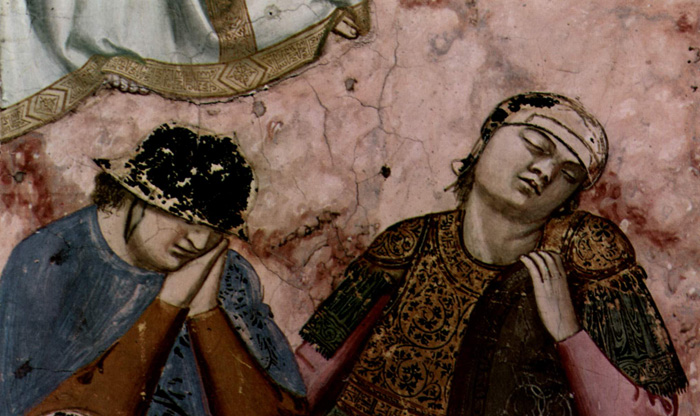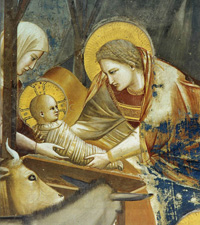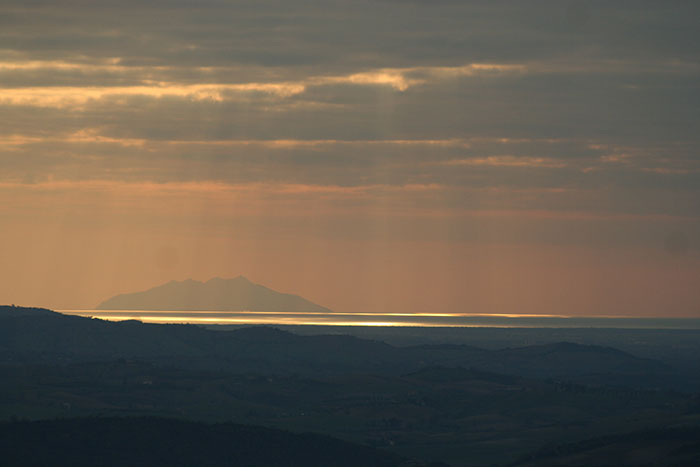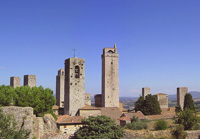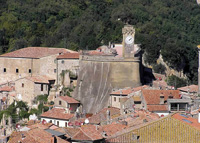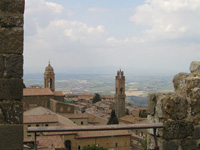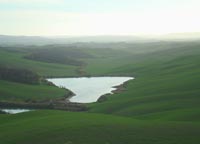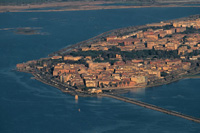Scenes from the Life of Christ
|
|
|
The youth of Christ and the story of his Passion are narrated on the two lower registers of the wall of the Scrovegni Chapel.
|
|
|
| The five scenes on the right wall represent the Nativity, the Adoration of the Magi, the Presentation in the Temple, the Flight into Egypt, and the Massacre of the Innocents. |
|
|
| |
|
|
|
1. Nativity: Birth of Jesus
|
| |
The simple shelter under which the Virgin and her Child seek refuge is situated in the middle of a bleak rocky landscape. Mary turns on her side on the bed in order to receive the new-born baby from the arms of a midwife — a natural and spontaneous gesture, which is captured by the way mother and child look at one another. Although on the periphery, this exchange of glances seems to be the actual centre of the portrayal, which is expanded to include the scene of the Annunciation to the shepherds. |
|
|
| |
|
|
|
| 2. Adoration of the Magi |
| |
With camels and gifts the three kings have followed the comet along the narrow rocky path to the stable at Bethlehem. On the fresco, this stable really does seem to be the end of the road. The oldest king has taken off his crown, and kneels before the baby Jesus. All present watch what is happening quietly and reverently. Only one vividly depicted secondary figure, the camel driver, prefers to attend to his animals. Giotto uses this contrast to increase the effect of the main scene. |
|
|
| |
| |
|
|
|
| |
|
|
|
3. Presentation of Christ at the Temple
|
| |
The baby Jesus wriggles in the arms of a priest, at whom he is looking, and reaches out for his mother, who approaches with open arms. These three figures are supported by the architecture behind them, and thus solemnly united as a group.
The temple in this scene is the same as that which appears in the Expulsion of Joachim from the Temple and the Presentation of the Virgin in the Temple, but this time we are shown only the shrine over the altar. |
|
|
| |
|
|
|
4. Flight into Egypt
|
| |
On a narrow rocky path, the procession seems to move past the viewer. Equipped with everyday objects, everyone is in motion, looking at one another and talking to one another - only the Virgin Mary sits still and unmoving. The statuesque nature other upright position is further reinforced by the rock behind. Although the child is as natural as can be, the central figures in the picture thus stand out from their surroundings and have a sublime effect. |
|
|
| |
|
|
|
5. Massacre of the Innocents
|
| |
A great number of slaughtered children lie on the ground. A soldier stands over the corpses and, at the command of King Herod (who appears in the painting himself), snatches a baby boy from his mother. The women scream, weep and try to protect their children. The men on the other side turn away, crushed and ashamed. |
|
|
| |
|
|
|
The six scenes on the left wall - Christ among the Doctors, the Baptism of Christ, the Marriage at Cana, the Raising of Lazarus, the Entry into Jerusalem, and the Expulsion of the Money-changers from the Temple - have the most solemn narrative tone of all the frescoes.
|
6. Christ among the Doctors
|
| |
In a rich red robe, the little twelve-year-old Jesus sits in the temple and holds a discussion - as his gesture quite clearly indicates. The arches of the architecture seem to echo the young boy's speech and at the same time to concentrate events on him. The scribes listen closely and in doing so show quite different reactions. Only one of them is completely distracted by the appearance of the worried parents. |
|
|
| |
|
|
|
7. Baptism of Christ
|
| |
In spite of the high quality details of this scene, the irrational representation of the water in which Christ stands indicates that Giotto was still influenced by medieval iconographic conventions. |
|
|
| |
|
|
|
8. Marriage at Cana
|
| |
The comic characterization of the guests and servants is noteworthy in this scene. |
|
|
| |
The detail shows the servants waiting to pour the wine in the Marriage at Cana. |
|
|
| |
|
|
|
9. Raising of Lazarus
|
| |
This scene is composed with the heightened effect of the gaze and gesture of Christ in mind. The rhythm of the individual gestures and the reactions of those present clearly show the energy which emanates from Christ, which startles the onlookers and wakes Lazarus from the dead. This energy carries on like an arrested wave into the narrative details: the arrangement of the folds in Lazarus' winding sheet or in the hitched up cloak of the disciple next to him are touched by it, as are the precisely characterized faces.
Giotto (or a pupil of Giotto) painted this scene again in the Magdalen Chapel of the Lower Church of San Frencesco at Assisi in a larger version, using the same figures with similar attitudes. |
|
|
| |
|
|
|
10. Entry into Jerusalem
|
| |
Accompanied by his disciples, Christ enters Jerusalem mounted on an ass. The people come to meet him in front of the city gate - we can recognize the Golden Gate on the right of the painting. To honour their Lord, some of them spread their clothes out on the ground. Giotto plainly demonstrates how events are progressing through the various stages of disrobing on the one side, and the movement of the donkey on the other. Movement and counter-movement give us the origin and the end of the procession. |
|
|
| |
|
|
|
| 11. Expulsion of the Money-changers from the Temple |
| |
The narrow bands that articulate the walls have a similar effect co Cosmati work on marble thrones. Marble with grotesque and floral elem ems, such as can be found on
portals of the period, and derived from antique modes, characterizes the broad bands. Narrative representations on the one hand, and angels and prophets on the other.
are depicted in the quatrefoils and multifoils respectively. They both complement the pictorial program and convey the impression that we are able co glimpse a layer lying further behind.
In the upper picture field we can see Christ driving out the readers with a violent gesture. The latter start with fright, the animals jump free, the children seek the protection of the disciples, and the scribes whisper to one another perfidiously. The span between the scribes and the touching gesture with which John presses a child to his side emphasize Christ's actions.
In the representation below this, Pentecost is being celebrated in a structure set obliquely in space, and whose Gothic arcades permit a view of the interior. The disciples are gathered, and rays from the Holy Ghost descend upon them. Their faces show astonishment and transfiguration. |
|
|
| |
|
|
|
12. Judas' Betrayal
|
| |
This scene, very seldom depicted, is displayed on the triumphal arch wall. The scribes, who were whispering in the preceding scene, The Driving of the Traders from the Temple, persuade Judas to betray his master. Judas, with the Devil at his back and holding a sack of gold, exchanges a knowing glance with the Pharisee.
After the scene of Judas' Betrayal on the triumphal arch wall, the story continues on the tier below, on the window-side (right side) of the chapel. Here we have a symmetrical arrangement (an outdoor scene flanked by two indoor scenes) of scenes from the Passion of Christ - the Last Supper, the Washing of Feet, the Kiss of Judas, Christ before Caiaphas, and the Flagellation. |
|
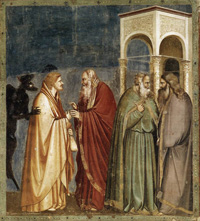 Scenes from the Life of Christ: 12. Judas' Betrayal Scenes from the Life of Christ: 12. Judas' Betrayal
1304-06
Fresco, 150 x 140 cm
Cappella Scrovegni (Arena Chapel), Padua |
| |
|
|
|
13. Last Supper
|
| |
The story continues with the scenes from the Passion of Christ. |
|
|
| |
|
|
|
14. Washing of Feet
|
| |
The washing of the feet takes place in an open room. This event is portrayed in a most lifelike manner: one disciple is busy putting his sandals back on, another is scratching his foot, and Peter is gathering up his robe to prevent it getting wet. In spite of the many narrative touches, Giotto still concentrates his depiction on the exchange between Christ and Peter. The latter puts his hand to his head, obviously unable to believe what his Lord is telling him. |
|
|
| |
|
|
|
15. The Arrest of Christ (Kiss of Judas)
|
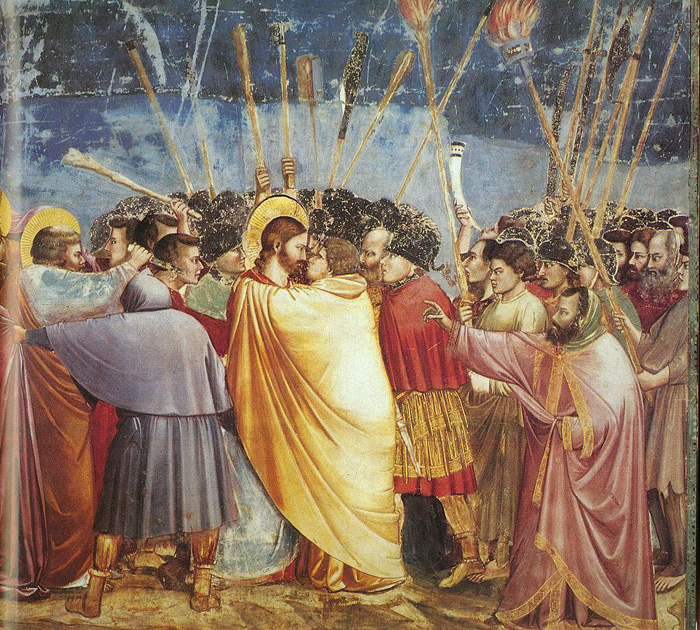 |
Giotto di Bondone, No. 31 Scenes from the Life of Christ: 15. The Arrest of Christ (Kiss of Judas), 1304-06, fresco, 200 x 185 cm, Cappella Scrovegni (Arena Chapel), Padua
|
Through their facial expressions and gestures the figures in the Arena Chapel paintings present a spectrum of feelings and moods never seen before. The meeting of eyes between Judas and Christ, the one looking on mildly, the other fanatically fixed in his gaze is an example which says it all.
This dramatic scene takes place at night. Torches shine out among the sticks and halberds against the blue of the sky. The throngs of people crowd into the centre, towards Christ, who is betrayed by Judas' kiss. Every movement, even that of Peter as he cuts off the ear of an attacker, and every gaze heightens the tension of the central confrontation.
With the force of his body Judas presses against Christ, who appears to disappear beneath the traitor's cloak. This expresses the inevitable outcome of this overwhelming confrontation. Surrounded and hemmed in by numerous faces, the profiles of Christ and Judas almost collide. The two look at one another — the one with dignity and seriousness, the other full of malice. The whole drama of the event is captured in this infinitely long exchange of glances. |
| |
|
|
|
16. Christ before Caiaphas
|
| |
The scene takes place in an enclosed, darkened room. One torch is lit and only one window is slightly open. Caiaphas' seat is raised up. He tears his robe in anger, while the soldiers bring Christ in. In the previous frescoes Christ appeared in profile or half-profile. Here his face is shown frontally. In this way Giotto illustrates a change - Christ seems to have lost all his vigour. |
|
|
| |
|
|
|
17. Flagellation
|
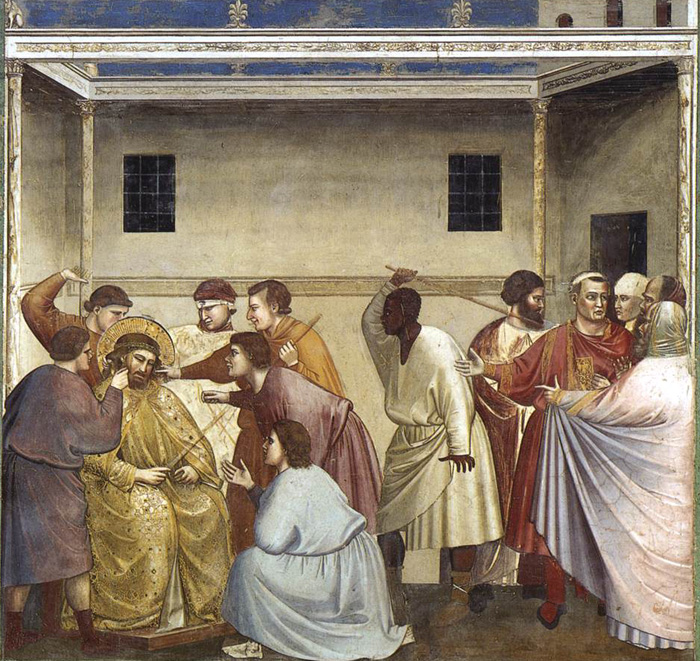 |
Giotto di Bondone, No. 33 Scenes from the Life of Christ: 17. Flagellation, 1304-06, fresco, 200 x 185 cm, Cappella Scrovegni (Arena Chapel), Padua
|
| The contrast between the caricature-like figures and the introverted Christ, who has had the royal mantle wrapped round him in mockery, could not be greater. Two completely different worlds are depicted in the one picture. As in all the scenes which follow his arrest, Giotto also shows Christ here as a changed character: submissive and lacking all vitality. |
| This detail shows the torturers of Christ in the Flagellation scene. |
|

|
| |
|
|
| In the lower tier on the left wall are the Road to Calvary, the Crucifixion, the Lamentation, the Resurrection (represented by the Noli me tangere scene instead of the three Marys at the tomb), the Ascension, and the Pentecost. |
| |
|
|
|
18. Road to Calvary
|
|
|
| |
The crowd of people has left Jerusalem en route to the hill of Calvary by the Golden Gate. Some push the unhappy mother back, others drive Christ onward. The latter appears isolated to the right of the centre of the painting, thus illustrating the loneliness of his journey. At the same time, Giotto creates the impression of a procession using the two truncated figures on the right edge of the picture. |
|
|
| |
|
|
|
19. Crucifixion
|
|
|
| |
The crucified Christ towers over the two groups of figures. Angels swarm around him with a great variety of reactions of grief and pain. Mary Magdalene has fallen at his feet, her cloak has slipped unnoticed from her shoulders - her delicately painted, superb head of hair is now her only adornment. His mother, the Virgin Mary, collapses in a faint, while on the other side the soldiers fight over Christ's mantle. The centurion has recognized Christ and is attempting to point him out to the others.
Some of the most dramatic parts in the Crucifixion and the following Lamentation are played by the small angelic spirits, who appear to have the lower part of their bodies hidden by clouds, a much more effective solution than that devised for the angelic spirits at Assisi, whose bodies are merely truncated. These small beings communicate their almost savage desperation through an extraordinary variety of attitudes and facial expressions not given to their human counter parts. |
|
|
| |
|
|
|
| 20. Lamentation (The Mourning of Christ) |
|
|
| |
With varied gestures, indicating individual degrees of sorrow, the women and John approach the body of Christ. Their gestures seem to pave the way for the most intense impression of grief, the embrace and gaze of the mother. At the same time, the gestures of the women and of the disciples, which are reflected once more by the angels, appear like a development of the mother's sorrow, which is concentrated on the moment of the most intimate encounter. |
|
|
| |
|
|
|
21 Resurrection (Noli me tangere)
|
|
|
| |
Mary Magdalene recognizes Christ on Easter morning in front of the open tomb. She attempts to speak to her Lord and to touch him. He refuses, with the words "Touch me not". Giotto depicts the in-between status of Christ - no longer of this world, but not yet of the next world — through the wavering posture and the delicate coloring. The contrast with Mary Magdalene and the sleeping soldiers heightens this impression. |
|
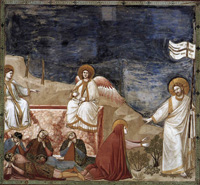
|
| |
The figures of the sleeping soldiers provided Giotto with the opportunity for doing some virtuoso foreshortening, as in the Resurrection at Assisi.
Giotto di Bondone | Resurrection (Noli me tangere) |
|
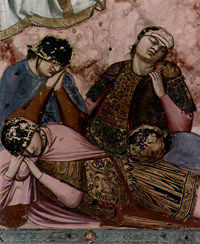 |
| |
|
|
|
22. Ascension
|
|
|
| |
The Ascension and the Pentecost are not among the most famous of the Arena Chapel frescoes, despite their very high quality. |
|
|
| |
|
|
|
23. Pentecost
|
| |
Pentecost is being celebrated in a structure set obliquely in space, and whose Gothic arcades permit a view of the interior. The disciples have gathered, and rays from the Holy Ghost descend upon them. Their faces show astonishment and transfiguration. It is worth noting that the setting of the Pentecost is very nearly the only one at Padua that directly reflects contemporary Gothic architecture. |
|
|
| |
|
|
|
| |
|
|

